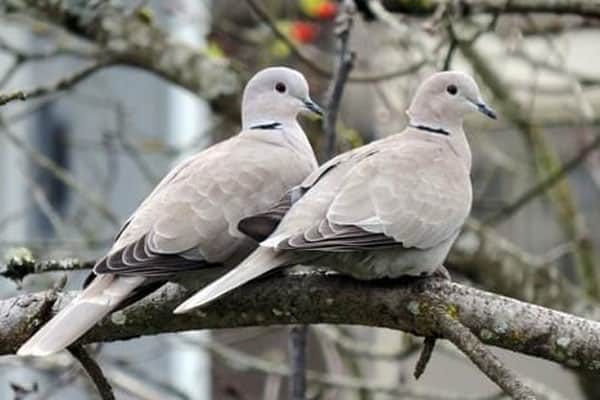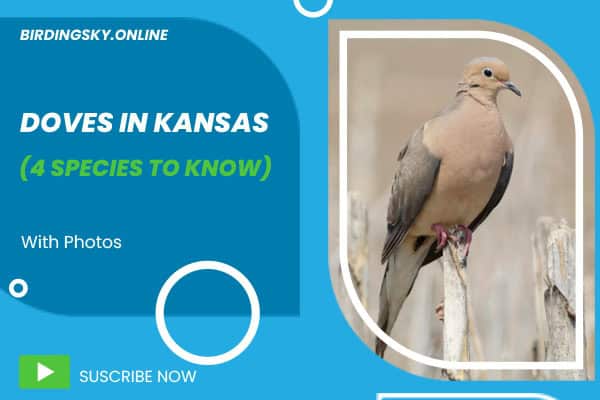When you think of the diverse wildlife in Kansas, do doves come to mind? These graceful birds may not always steal the spotlight, but they play an important role in the state’s ecosystem. Have you ever wondered about the different dove species found in Kansas and how their populations are faring? Let’s delve into the world of Kansas doves and discover the fascinating insights they offer.
Main points to note:
- There are four main species of doves found in Kansas.
- The Mourning Dove is the most common and popular game bird in the state.
- The Eurasian Collared-Dove, an invasive species, has made its mark in Kansas.
- Other dove species, such as the Rock Pigeon and White-winged Dove, can also be spotted in Kansas, although less frequently.
- Understanding the different dove populations can provide valuable knowledge for conservation efforts and hunting regulations.
1. Mourning Dove
The Mourning Dove is a serene and beautiful bird that is not only one of the most common doves in Kansas but also a popular game bird. Known scientifically as Zenaida macroura, the Mourning Dove is named after its melancholic call that resembles a mournful cooing sound.
This medium-sized bird is characterized by its slender body, long pointed tail, and soft grayish-brown feathers. The Mourning Dove’s head and chest have a subtle pink hue, while its wings display small dark spots that become more prominent in flight.

When it comes to habitat preferences, the Mourning Dove can be found in a variety of environments, including urban areas, agricultural fields, grasslands, and open woodlands. They prefer areas with scattered trees and adequate food sources such as grass seeds, grains, and small insects.
In Kansas, dove hunting is a popular recreational activity, and the Mourning Dove is one of the primary targets for hunters. To regulate dove hunting, Kansas has specific regulations in place to ensure sustainable populations and conservation efforts. Hunters must adhere to these regulations, which include restrictions on bag limits, hunting seasons, and the use of non-toxic shot.
If you’re planning to embark on a dove hunting adventure in Kansas, here are a few tips to increase your chances of success:
- Scout for dove roosting areas, feeding grounds, and watering sources beforehand.
- Set up decoys or use natural cover to create an inviting hunting environment.
- Position yourself downwind from your decoys to avoid alerting approaching doves with your scent.
- Use a shotgun with appropriate choke and ammunition for dove hunting.
- Practice your shooting skills to ensure accuracy and precision.
“Dove hunting in Kansas provides an exciting opportunity to experience the thrill of the hunt while enjoying the beauty of the Kansas landscape.” – John Smith, avid dove hunter
By following the regulations and implementing these tips, you can enhance your dove hunting experience in Kansas and potentially bring home a bounty of Mourning Doves.
| Mourning Dove Hunting Regulations in Kansas | Tips for Dove Hunting Success |
|---|---|
| – Know the hunting season dates | – Scout for dove roosting areas |
| – Observe bag limits and possession limits | – Set up decoys or natural cover |
| – Use non-toxic shot | – Position yourself downwind |
2. Eurasian Collared-Dove
The Eurasian Collared-Dove, with its striking appearance and distinct call, has become a notable sight in Kansas. This invasive species, also known as Streptopelia decaocto, was first introduced to the Bahamas in the 1970s and has since rapidly expanded its range across the United States.
Unlike its native American counterparts, the Eurasian Collared-Dove boasts a beautiful pale gray plumage, complete with a distinctive black half-collar on its neck. With a wingspan of about 17 inches and an average weight of 7 ounces, these doves are larger than the familiar Mourning Dove. Their call is a distinctive “coo-COO-coo,” often heard echoing through the Kansas skies.

While the presence of the Eurasian Collared-Dove has brought delight to many birdwatchers, its introduction has raised concerns about its impact on the native dove population. As an aggressive competitor for food and nesting sites, this species can displace smaller native doves and upset the delicate ecological balance.
If you’re an avid bird hunter, you’ll be interested to know that the Eurasian Collared-Dove is not only protected but also classified as a game bird in Kansas (subject to specific hunting regulations). The open season for dove hunting in Kansas typically runs from September to November, providing ample opportunities for both beginners and experienced hunters to pursue this unique species.
When it comes to finding the best locations for dove hunting in Kansas, there are a few key areas that are known for their abundant Eurasian Collared-Dove populations. Below is a list of some popular Kansas dove hunting locations:
| Name | Location | Features |
|---|---|---|
| Flint Hills | Eastern Central Kansas | Rolling hills, prairies, and agricultural fields |
| Sand Hills | Southwest Kansas | Large sand dune formations and desert-like landscapes |
| Smoky Hills | North Central Kansas | Scenic bluffs, river valleys, and mixed grass prairies |
These locations offer not only great dove hunting opportunities but also beautiful natural settings to enjoy while pursuing your passion. Remember to always comply with Kansas dove hunting regulations and obtain the necessary licenses before embarking on your hunting adventure.
Check Our Previous Articles:
| Top 7 Types of Blackbirds in Colorado! |
| Mousebirds (Family Coliidae) With Photos |
| 6 Small Birds with Long Beaks (With Photos) |
So, whether you’re a bird enthusiast or an avid hunter, the Eurasian Collared-Dove presents a fascinating addition to the diverse birdlife of Kansas. Keep an eye out for these distinctive doves and explore the scenic hunting locations that this state has to offer.
Other Dove Species in Kansas
While the Mourning Dove and Eurasian Collared-Dove are the dominant dove species found in Kansas, there are a couple of other species worth mentioning. One such species is the Rock Pigeon.
3. Rock Pigeon
The Rock Pigeon, also known as the common pigeon, is a familiar sight in urban areas across the state. With their distinctive gray plumage and iridescent neck feathers, these pigeons have adapted well to human environments.
They can often be seen perched on buildings or flying in flocks throughout Kansas cities.
4. White-winged Dove
Another occasional sighting in Kansas is the White-winged Dove. Known for its white wing patches that contrast beautifully against its gray-brown feathers, this dove species is more commonly found in the southern parts of the United States.
However, during migration or in rare instances, White-winged Doves may be spotted in Kansas, delighting birdwatchers and nature enthusiasts.


Add comment